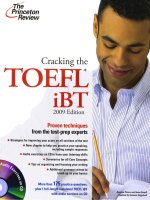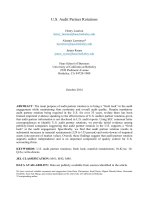U.S. Government & Politics Ques - Princeton Review
Bạn đang xem bản rút gọn của tài liệu. Xem và tải ngay bản đầy đủ của tài liệu tại đây (5.19 MB, 1,213 trang )
Editorial
Rob Franek, Senior VP, Publisher
Mary Beth Garrick, Director of Production
Selena Coppock, Senior Editor
Calvin Cato, Editor
Kristen O’Toole, Editor
Meave Shelton, Editor
Alyssa Wolff, Editorial Assistant
Random House Publishing Team
Tom Russell, Publisher
Alison Stoltzfus, Publishing Director
Ellen L. Reed, Production Manager
Dawn Ryan, Managing Editor
Erika Pepe, Associate Production Manager
Kristin Lindner, Production Supervisor
Andrea Lau, Designer
The Princeton Review, Inc.
111 Speen Street, Suite 550
Framingham, MA 01701
E-mail:
Copyright © 2013 by TPR Education Holdings IP, LLC
Cover art © Jonathan Pozniak
All rights reserved. Published in the United States by Random House
LLC, New York, a Penguin Random House Company, and in Canada by
Random House of Canada Limited, Toronto, Penguin Random House
Companies.
eBook ISBN: 978-0-8041-2442-3
Trade Paperback ISBN: 978-0-8041-2443-0
The Princeton Review is not affiliated with Princeton University.
AP and Advanced Placement Program are registered trademarks of
the College Board, which does not sponsor or endorse this product.
Editor: Meave Shelton
Production Editor: Beth Hanson
Production Coordinator: Blake Dennis
v3.1
Acknowledgments
The Princeton Review would like to give
special thanks to the following individuals
for their hard work on and contributions to
this book: Mike Hernandez, Peter Hanink,
Eliz
Markowitz,
Bryan
Cunningham,
Jennifer Amerkhanov, Kevin Kelly, David
Stradley, Chris Stobart, and David Stoll.
Contents
Cover
Title Page
Copyright
Acknowledgments
Part I: Using This Book to
Improve Your AP Score
Preview:
Your
Expectations
Knowledge,
Your Guide to Using This Book
How to Begin
Your
Diagnostic Test
Diagnostic
Test:
Explanations
Answers
and
Part II: About the AP U.S.
Government and Politics
Exam
The Structure of the AP
Government and Politics Exam
U.S.
How the AP U.S. Government and
Politics Exam is Scored
How AP Exams Are Used
Other Resources
Designing Your Study Plan
Part III: Test-Taking
Strategies for the AP
U.S. Government and
Politics Exam
1
How to Approach Multiple-Choice
Questions
2
How to Approach Free-Response
Questions
Part IV: Drills
3
Constitutional Underpinnings
4
Constitutional Underpinnings: Answers
and Explanations
5
Political Beliefs and Behaviors
6
Political Beliefs and Behaviors: Answers
and Explanations
7
Political Parties, Interest Groups, and
Mass Media
8
Political Parties, Interest Groups, and
Mass Media: Answers and Explanations
9
Institutions of Government
10 Institutions of Government: Answers
and Explanations
11 Public Policy
12 Public Policy: Answers and Explanations
13 Civil Rights and Civil Liberties
14 Civil Rights and Civil Liberties: Answers
and Explanations
Part V: Practice Exam
15 Practice Test
16 Practice Test: Answers and Explanations
Part I
Using This Book
to Improve Your
AP Score
Preview: Your
Expectations
Knowledge,
Your
Your Guide to Using This Book
How to Begin
Diagnostic Test
Diagnostic
Test:
Answers
and
Explanations
PREVIEW: YOUR
KNOWLEDGE, YOUR
EXPECTATIONS
Your route to a high score on the AP U.S.
Government and Politics Exam depends a
lot on how you plan to use this book. Start
thinking about your plan by responding to
the following questions.
1. Rate your level of confidence about
your knowledge of the content tested by
the AP U.S. Government and Politics
Exam.
A. Very confident—I know it all.
B. I’m pretty confident, but there
are topics for which I could use
help.
C. Not confident—I need quite a
bit of support.
D. I’m not sure.
2. If you have a goal score in mind,
identify your goal score for the AP U.S.
Government and Politics Exam.
3. What do you expect to learn from this
book? Circle all that apply to you.
A. A general overview of the test
and what to expect
B. Strategies for how to approach
the test
C. To identify the content topics
for which I need the most
practice
D. I’m not sure yet.
YOUR GUIDE TO USING THIS
BOOK
This book is organized to provide as much—
or as little—support as you need, so you can
use this book in whatever way will be most
helpful for improving your score on the AP
U.S. Government and Politics Exam.
The remainder of Part I will provide
guidance on how to use this
book.
a diagnostic practice test, with
answers and explanations, to
help you determine your
strengths and weaknesses.
Part II of this book will
provide information about the
structure, scoring, and content of
the AP U.S. Government and
Politics Exam.
help you to make a study plan.
point you toward additional
resources.
Part III of this book will explore
various strategies:
how to attack multiple choice
questions
how to write a high scoring freeresponse answer
Part IV of this book contains drills
organized according to the topics tested
on the exam.
Part V of this book contains a second
practice test, with answers and
explanations.
You may choose to use some parts of this
book over others, or you may work through
the entire book. This will depend on your
needs and how much time you have. Let’s
now look how to make this determination.
HOW TO BEGIN
1. Take a Test
Before you can decide how to use this
book, you need to take a practice test.
Doing so will give you insight into your
strengths and weaknesses, and the test
will also help you make an effective
study plan. If you’re feeling test-phobic,
remind yourself that a practice test is a
tool for diagnosing yourself—it’s not
how well you do that matters but how
you use information gleaned from your
performance to guide your preparation.
So before you read further, take the full-
length Diagnostic Test starting at this
page of this book. Be sure to do so in
one sitting, following the instructions
that appear before the test.
2. Check Your Answers
Using the answer key on this page,
count how many multiple-choice
questions you got right and how many
you missed. Don’t worry about the
explanations for now, and don’t worry
about why you missed questions. We’ll
get to that soon.
3. Reflect on the Test
After you take your first test, respond to
the following questions:
How much time did you spend on
the multiple-choice questions?
How much time did you spend on
each free-response question?
How many multiple-choice
questions did you miss?
Do you feel you had the
knowledge to address the subject
matter of the essays?
Do you feel you wrote wellorganized, thoughtful essays?
Circle the content areas that were
most challenging for you and
draw a line through the ones in
which you felt confident/did well.
Constitutional
Underpinnings: Principles
of democratic government,
framers, federalism, checks
and balances, separation of
powers, etc.
Political Beliefs and
Behaviors: Ideological
beliefs about government,
political socialization,
voting, mass movements,
etc.
Political Parties, Interest
Groups, and Mass Media:
Organization and
communication of citizens’
interests and concerns,
elections, PACs, etc.
Institutions of National
Government: Organization
and powers of major
political institutions, ties
between branches of
government, etc.
Public Policy: Formation,
enactment,
implementation, and
interpretation of policy;
impact of federalism,
interest groups, parties,
elections, etc.
Civil Rights and Civil
Liberties: U.S. Supreme
Court decisions, judicial
interpretations, impact of
the Fourteenth
Amendment, etc.
4. Read Part II and Complete the SelfEvaluation
As discussed in the Guide section above,
Part II will provide information on how
the test is structured and scored. It will
also explain the areas of content that
are tested.
As you read Part II, re-evaluate your
answers to the questions above. At the
end of Part II, you will revisit and
refine the questions you answer above.
You will then be able to make a study
plan, based on your needs and time
available, that will allow you to use this
book most effectively.
5. Engage with Parts III and IV as
Needed
Notice the word engage. You’ll get more
out of this book if you use it
intentionally than if you read it
passively, hoping for an improved score
through osmosis.
Strategy chapters will help you think
about your approach to the question
types on this exam. Part III will open
with a reminder to think about how you
approach questions now and then close
with a reflection section asking you to
think about how/whether you will
change your approach in the future.
Drill chapters are organized according
to the content topics tested on the
exam. This allows you to focus on and
gain mastery of the areas in which you
need the most practice.
6. Take the Second Practice Test and
Assess Your Performance
Once you feel you have developed the
strategies you need and gained the
confidence you may have lacked, you
should take the Practice Test in Part V.
You should do so in one sitting,
following the instructions at the
beginning of the test.
When you are done, check your answers
to the multiple-choice section with the
correct responses beginning on this
page of this book. Then, see if a teacher
will read your essays and provide
feedback for your improvement.
Once you have taken the test, reflect on
what areas you still need to work on,
and revisit the chapters in this book
that address those topics. Through this
type of reflection and engagement, you
will continue to improve.
7. Keep Working
As we will discuss in Part II, there are
other resources available to you,
including a wealth of information on
AP Central. You can continue to explore
areas that can stand to improve and
engage in those areas right up to the
day of the test.







![brooks et al - 2012 - audit firm tenure and audit quality - evidence from u.s. firms [mafr]](https://media.store123doc.com/images/document/2015_01/06/medium_ayf1420548102.jpg)

